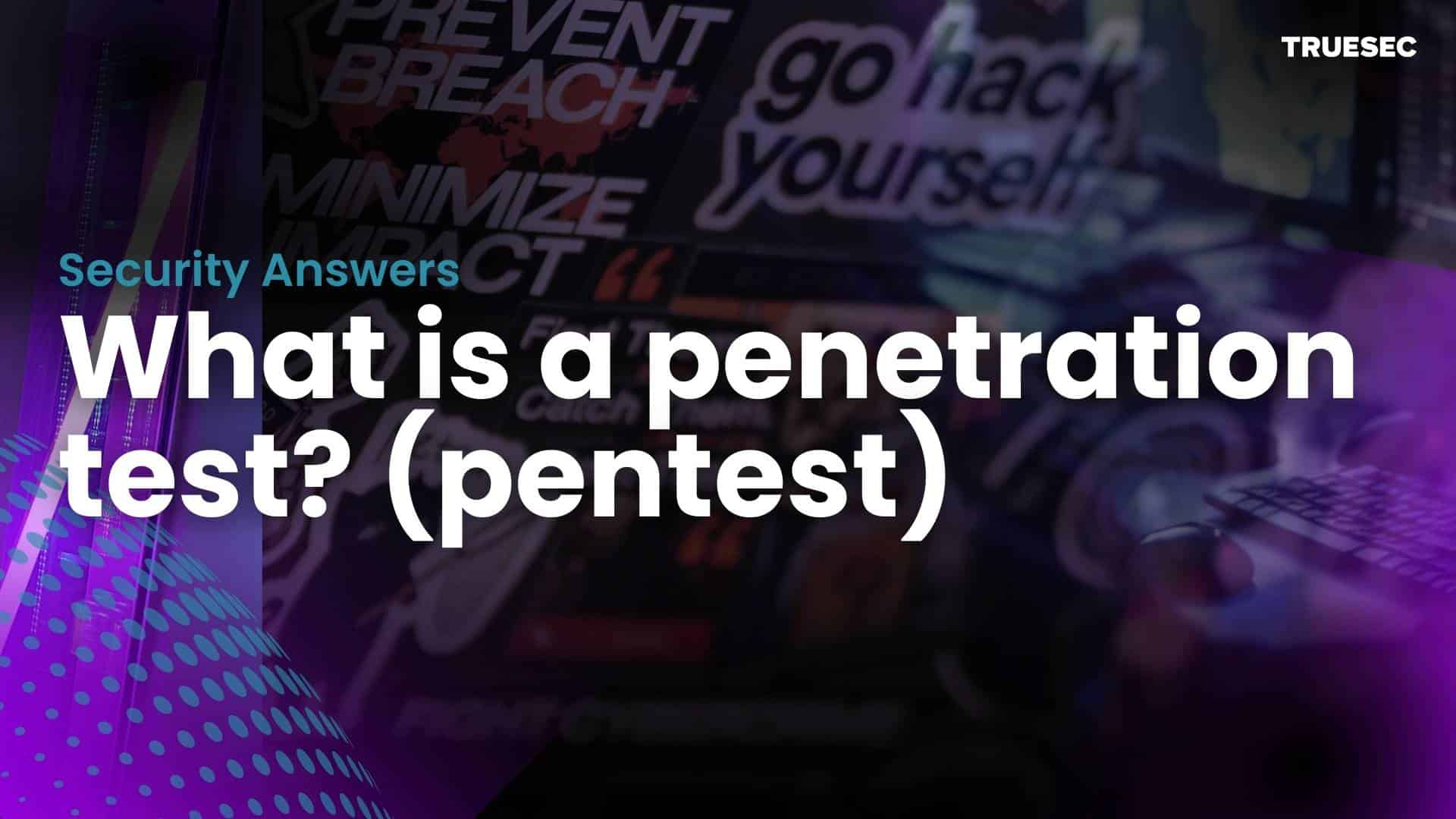Pentest – What’s a Penetration Test?


TLDR: The goal of a penetration test (help with penetration testing, book a pentest) is to identify and address security vulnerabilities and weaknesses before malicious attackers or cybercriminals can exploit them.
What’s a Pentest?
Penetration testing, often called “pentesting,” is an essential part of understanding an organization’s cybersecurity posture. It involves a methodical process where cybersecurity experts, known as pentesters, conduct simulated cyber attacks on computer systems, networks, or applications. At its core, a penetration test is about adopting the mindset and tactics of an attacker. Pentesters use various tools and strategies to probe for weaknesses in security defenses, much like a cybercriminal would, but with a crucial difference – their actions are legal, ethical, and intended to strengthen, not harm, the system.
Key Benefits of a Pentest
In essence, a penetration test is not just a tool for identifying weaknesses; it’s an essential practice for maintaining a robust and compliant cybersecurity posture against cybercrime. It plays a crucial role in empowering organizations to manage and mitigate cyber risks effectively while strengthening their cybersecurity defenses. Its strategic importance can be encapsulated in three key benefits:
1. Enhancing Security Posture
- Proactive Defense – Regular pentesting helps organizations stay ahead of cyber threats. Companies can fortify their defenses against potential cyber attacks by proactively identifying and addressing security gaps.
- Customized Security Strategies – Each pentest provides unique insights tailored to an organization’s specific architecture, leading to more effective and personalized security measures.
- Training and Preparedness – Pentests also serve as practical training scenarios for security teams, enhancing their readiness to respond to real-world cyber incidents.
2. Identifying Security Vulnerabilities
- Comprehensive Assessment – Pentesting scrutinizes various components of an IT system – from network infrastructure and applications to user behaviors and policies – to identify potential weaknesses and vulnerabilities.
- Real-World Attack Simulation – By simulating real-world attack scenarios, pentesting provides a realistic evaluation of how well a system can withstand cyber threats.
- Prioritized Remediation – The insights gained from pentest reports enable organizations to prioritize remediation efforts, focusing resources on the most critical vulnerabilities.
3. Compliance With Security Standards
- Regulatory Adherence – Many industries are governed by stringent cybersecurity regulations. Regular pentesting helps ensure compliance with these standards, such as GDPR, HIPAA, DORA, TIBER, or PCI-DSS.
- Demonstrating Due Diligence – By conducting regular penetration tests, organizations not only comply with legal requirements but also demonstrate their commitment to maintaining robust security practices.
- Avoiding Penalties – Staying compliant through pentesting also helps avoid potential legal penalties and fines associated with data breaches.

Who Performs a Pentest?
Understanding who performs pentests is crucial for any organization looking to improve its cybersecurity posture. With the right team, businesses can not only identify vulnerabilities but also develop a robust strategy to mitigate potential cyber threats, ultimately safeguarding their digital assets and maintaining customer trust. This is important because automated tools and less experienced staff might overlook some of the weak spots, leaving the customer with a false sense of security.
Pentesters use a variety of tools and strategies to probe for weaknesses in security defenses, much like a cybercriminal would.
But with a crucial difference – their actions are legal, ethical, and intended to strengthen, not harm, the system.
What’s a Pentester?
Ethical hackers, pentesters, offensive personnel, security researchers. The titles come in many forms, but in short: Penetration testing, pentesting or pen test is a highly specialized field within cybersecurity, requiring a unique blend of skills, knowledge, and high ethical standards. The professionals who conduct these tests are typically individuals with a deep understanding of both IT systems and hacking techniques.
These experts often have backgrounds in cybersecurity, information technology, or computer science and bring a diverse range of skills to the table, including in-depth knowledge of the latest hacking techniques, community-created open-source tools, network infrastructure, coding, and the ability to creatively think outside the box.
Having a Hacker’s Mindset
Simply put, pentesters are cybersecurity professionals who identify security vulnerabilities and weaknesses while using systems in ways they perhaps weren’t intended, commonly known as “the hackers’ mindset.”

At Truesec, our team of pentesters comprises seasoned cybersecurity professionals who aren’t just skilled at identifying and exploiting vulnerabilities but also adept at providing actionable insights and recommendations to fortify the tested systems and keep our customers secure.
What Does It Take To Be a Pentester?
To gain a basic understanding of what a pentester does, the skills they require, and how one becomes a pentester in the field of cybersecurity, here’s a breakdown:
Roles and Responsibilities
- Simulating Cyber Attacks – Pentesters simulate real-world cyber attacks under controlled conditions to find vulnerabilities in security systems.
- Vulnerability Assessment – They assess the severity of each vulnerability, understanding how an attacker could exploit it.
- Reporting and Guidance – Post-testing, pentesters compile detailed reports outlining discovered vulnerabilities and provide recommendations for strengthening security.
- Continuous Learning – As cyber threats evolve, pentesters must stay updated with the latest hacking techniques, tools, and security trends.
Required Skills and Expertise
- Technical Proficiency – Pentesters should have a strong grasp of networking, systems administration, and application development. Knowledge of programming languages like Python, JavaScript, or SQL is often essential.
- Analytical Skills – They must possess excellent problem-solving skills, capable of thinking like a hacker to identify potential security gaps.
- Communication Skills – The ability to clearly articulate findings and recommendations to technical and non-technical stakeholders is crucial.
- Ethical Integrity – Pentesters must adhere to high ethical standards, ensuring that their activities are legal, authorized, and intended to improve security.
Typical Background and Career Path
- Educational Foundation – Many pentesters have degrees in computer science, cybersecurity, or related fields, although some enter the field with diverse educational backgrounds.
- Gaining Experience – Entry-level positions in IT or cybersecurity can provide foundational experience. Roles like network administrator, system engineer, or developer are common starting points.
- Certifications – Obtaining certifications like the Offensive Security Certified Professional (OSCP), or CompTIA PenTest+ can be pivotal in advancing a pentesting career.
- Specialization and Growth – Experienced pentesters may specialize in areas like network, application, or cloud security and often progress to senior roles, consulting, or leading cybersecurity teams.
Becoming a pentester requires a mix of technical skills, ethical judgment, and continuous learning. It’s a dynamic and challenging role, but for those passionate about cybersecurity, it offers a fulfilling career path with the opportunity to make a significant impact in safeguarding organizations, fighting cybercrime, and protecting society.
How Is a Pen test Performed?
Today, as cybercrime presents a major challenge, it’s essential for organizations to strengthen their cybersecurity measures. Pentesting plays a pivotal role in this context. A pentest is essentially a controlled and proactive simulation of an attack designed to identify, understand, and address security vulnerabilities within an organization. By simulating real-life cyber threats, pentesting allows organizations to evaluate and improve their defense mechanisms against potential cyber attacks effectively. While the process might differ between cybersecurity businesses and what the customer needs, here’s a quick breakdown of how a typical pentest could be performed.
Planning
- Defining Objectives – The first step involves setting clear goals for the pentest. This might include determining which systems to test and the type of pentesting to be conducted (e.g., black box, white box, or grey box testing.)
- Scoping – This phase outlines the boundaries of the test, including timelines, testing methods, and areas to be tested, ensuring all activities are authorized and legal.
- Collection of Relevant Materials – Essential documents, source code, and other relevant materials are gathered to inform and guide the test.
Reconnaissance
- Passive Reconnaissance – This involves collecting information without directly interacting with the target systems. It could include public data gathering, OSINT such as domain name registrations, issued certificates, and network information using passive sources.
- Active Reconnaissance – Here, pentesters interact with the target systems, identifying available services, finding potential vulnerabilities, and understanding how the systems respond to various inputs.
Exploitation
- Identifying Vulnerabilities – Utilizing the information gathered, pentesters attempt to exploit identified vulnerabilities. This might involve bypassing security controls, escalating privileges, or extracting sensitive data.
- Documentation – Throughout the exploitation phase, pentesters meticulously document their findings, including how they were able to penetrate the system.
Reporting
- Comprehensive Reporting – After the testing, pentesters compile a detailed report. This includes a summary of exploited vulnerabilities, the data exposed, and the level of risk involved.
- Remediation Recommendations – The report also provides prioritized recommendations for remediation to close the identified security gaps.
- Follow Up – Sometimes, a retest is recommended to ensure that the remediations are effective.
Best Practices in Conducting a Pentest
The process of a pentesting operation is a meticulous and adaptive journey. It’s a blend of technical knowledge, challenges, strategic planning, and ethical responsibility. To ensure the experience of a pentest, which can be quite daunting for customers at first, is as positive as possible, some of the following best practices should be considered:
- Ethical Conduct – Pentesters must always operate within legal and ethical boundaries, with proper authorization for all their activities.
- Clear Communication – Ongoing communication with stakeholders throughout the process is crucial for ensuring alignment and addressing any concerns.
- Adaptability – Pentesters should be prepared to adapt their strategies based on the findings during the test.
- Thoroughness – Comprehensive testing and detailed reporting are essential for providing actionable insights to improve security.
Common Pentesting Methods and Tools
Diving Into Pentesting Techniques and Essential Tools
Pentesting encompasses a range of methodologies and utilizes a suite of sophisticated tools. These methods and tools are integral to identifying and addressing vulnerabilities in cybersecurity systems.
Pentesting Methodologies
- Black Box Testing – This simulates an external cyber attack where testers have no prior knowledge of the system. It provides an authentic perspective of how an actual attacker might perceive and exploit system vulnerabilities.
- White Box Testing – The opposite of black box testing, here, testers have full knowledge of the system, including access to source code, network diagrams, and credentials. This comprehensive approach allows for a thorough assessment of all parts of the system.
- Source Code Review – Although this might be more aimed toward AppSec, having access to source code during a pentest makes a huge difference. Source code review involves a detailed examination of application source code to identify security flaws. Unlike dynamic testing, it’s a static method that can pinpoint specific lines of code responsible for vulnerabilities, enabling more targeted and effective security measures.
By effectively combining these methodologies with tools, pentesters can conduct comprehensive security assessments. Each tool, from Nmap’s network mapping to Hashcat’s password cracking, plays a critical role in the pentesting process, revealing vulnerabilities and bolstering cybersecurity defenses.
Popular Tools and Technologies Used in Pentesting
- Nmap (Network Mapper) – An essential tool for network discovery and security auditing. Nmap identifies devices on a network and determines the services and operating systems they are running.
- Burp Suite (Burp Proxy) – A favorite for web application testing, Burp Suite acts as an intercepting proxy, allowing modification and re-issuance of requests to web servers and analysis of the responses.
- Shodan – Known as the “search engine for hackers,” Shodan scans for internet-connected devices, aiding pentesters in identifying exposed devices and potential entry points for attackers.
- Bloodhound – Used for mapping out relationships within an Active Directory (AD) environment. Bloodhound helps identify complex attack paths that could be exploited in a privilege escalation scenario.
- Wireshark – A network protocol analyzer crucial for network analysis and troubleshooting, allowing real-time monitoring of network traffic.
- Hashcat – Renowned for its password-cracking capabilities, Hashcat is used to test password strength and recover lost or forgotten passwords through various attack methods.
Legal and Ethical Aspects of Pentesting
Navigating the Legalities and Ethics in Pentesting
Pentesting is not just a technical endeavor but also one that demands a keen understanding of legal and ethical considerations. Adhering to these principles is crucial for maintaining the integrity of the practice and ensuring that pentesting activities are conducted responsibly.
Understanding the Legal Framework
- Authorization – A cardinal rule in pentesting is obtaining explicit, written authorization from the organization owning the systems being tested. This legal consent is essential to distinguish ethical pentesting from cybercrime and malicious attacks.
- Scope of Work – The legal agreement should clearly define the scope of the pentest, including the systems to be tested, the methods to be used, and the duration of the test. This clarity helps prevent overstepping legal boundaries.
- Compliance With Laws – Pentesters must be aware of and comply with relevant laws and regulations, which can vary widely by region. This includes laws related to data protection, privacy, and computer misuse.
- Confidentiality – Maintaining the confidentiality of any discovered vulnerabilities and sensitive information is a legal obligation. Disclosing such information without consent can lead to legal repercussions.
Ethical Considerations and Professional Conduct
- Respect for Privacy – Ethical pentesters respect the privacy of the organization and its users. Any personal data encountered during a pentest should be handled with the utmost confidentiality and integrity.
- Integrity in Reporting – Ethical reporting involves providing an honest, accurate account of the findings without exaggeration or downplaying the risks. It’s about helping organizations understand their vulnerabilities, not instilling undue fear.
- Continuous Learning – Ethical pentesters commit to continuous learning, staying updated with the latest legal guidelines, ethical standards, and technical advancements in the field.
What’s the Difference Between a Pentest and a Red Team?
The terms “red team engagement” and “penetration test” (pentest) are often used in cybersecurity, but they refer to different approaches and objectives. Here’s a breakdown of the key differences:
Red Team Engagement
- Objective – The primary goal of a red team engagement is to assess the effectiveness of the entire security program of an organization. It simulates a real-world attack scenario to test how well an organization’s defensive strategies (the blue team) can detect and respond to an advanced persistent threat.
- Scope – Red team engagements are broader and more comprehensive. They often involve a full-spectrum attack simulation, including social engineering, physical security breaches, application security, network security, and more.
- Duration – These engagements are typically longer in duration, sometimes lasting several weeks or months, to allow for in-depth testing and the simulation of advanced persistent threats.
- Approach – Red teams use a covert approach, mimicking the tactics, techniques, and procedures (TTPs) of real attackers as closely as possible. The organization’s security team is usually unaware of the specific details of the attack, making it a true test of their response capabilities.
- Results – The outcome is a comprehensive understanding of how an organization responds to an attack, identifying gaps in both technical defenses and organizational processes.
Penetration Test (Pentest)
- Objective – The aim of a pentest is more focused, usually aimed at identifying and exploiting vulnerabilities in a specific system, application, or network.
- Scope – Pentests are typically more limited in scope, targeting specific areas or systems. They might be confined to a network, an application, a system, or a specific security control.
- Duration – Pentests are generally shorter and often conducted over a few days or weeks, depending on the scope and objectives.
- Approach – Pentesters often operate with some level of prior knowledge about the system (white box testing) and focus on exploiting known vulnerabilities. They typically work within the defined scope and do not use techniques that could disrupt the organization’s operations.
- Results – The result is a detailed report of vulnerabilities discovered, with recommendations for remediation. The focus is more on technical findings rather than organizational response capabilities.
In essence, a red team engagement is a full-scale, realistic simulation of an advanced cyber attack to test an organization’s detection and response capabilities, whereas a pentest is a more focused, technical assessment of specific systems or applications to identify vulnerabilities. Both are crucial in a comprehensive cybersecurity strategy but serve different purposes.
Understanding the Red, Blue, Purple, and White Teams in Cybersecurity
Red Team
The red team’s role is akin to that of an attacker, employing offensive strategies to test an organization’s defenses. They use realistic attack scenarios to identify vulnerabilities in systems, networks, and physical security. The goal of the red team is to challenge security measures and uncover weaknesses before actual attackers do.
Blue Team
The blue team is the defensive counterpart to the red team. Their primary responsibility is to detect, prevent, and respond to attacks. They use various tools and strategies to strengthen the organization’s defense systems, continually updating security measures to protect against identified vulnerabilities and ongoing threats.
Purple Team
A purple team is essentially a collaborative effort between the red and blue teams. It focuses on maximizing the effectiveness of both offensive and defensive strategies. By combining insights from both perspectives, purple teams work to ensure that security measures are both robust and resilient, closing gaps identified by red team exercises and enhancing the defensive tactics of the blue team.
White team
The white team typically plays an administrative and oversight role. They are responsible for managing the rules of engagement, ensuring that both red and blue teams operate within agreed parameters and objectives. In training exercises and simulations, the white team acts as referees, providing guidance, adjudicating outcomes, and ensuring a constructive and ethical approach to cybersecurity testing and improvement.
The Future of Pentesting
Anticipating the Evolution of Cybersecurity With Emerging Trends and Technologies
The field of pentesting is ever-evolving, shaped by advancing technology and the dynamic nature of cyber threats. Understanding the future trends in pentesting is crucial for cybersecurity professionals to stay ahead of potential vulnerabilities and emerging attack vectors.
Emerging Trends and Technologies
- Artificial Intelligence and Machine Learning – AI and ML are becoming integral in automating complex pentesting tasks. These technologies can analyze vast amounts of data for patterns and anomalies more efficiently than humans, enhancing the effectiveness of vulnerability assessments.
- IoT and Smart Device Testing – With the proliferation of internet of things (IoT) devices, pentesting is expanding its scope to include these devices. The complexity and variety of IoT ecosystems present new challenges and vulnerabilities.
- Cloud Security – As more organizations migrate to cloud-based solutions, pentesting in cloud environments is becoming increasingly critical. This includes testing cloud storage, applications, and infrastructure for potential weaknesses.
- Mobile Application Security – The surge in mobile app usage necessitates focused pentesting for mobile platforms, addressing unique security concerns in iOS, Android, and other mobile operating systems.
Evolution of Threats and Pentesting Responses
- Advanced Persistent Threats (APTs)– Pentesters are adapting to more sophisticated, long-term threats posed by APTs. These require a more in-depth and continuous approach to identify and mitigate.
- Ransomware and Phishing – With the rise of ransomware and sophisticated phishing attacks, pentesters are developing specialized techniques to simulate and defend against these types of attacks.
- Regulatory Changes – As data protection and privacy regulations evolve, pentesting methodologies are adapting to ensure compliance and to protect sensitive user data effectively.
- Community and Collaboration – The future of pentesting also lies in the growing community and collaboration efforts. Sharing knowledge, tools, and techniques within the community helps in collectively addressing emerging cybersecurity challenges.
The future of penetration testing is a landscape of continual adaptation and advancement. As new technologies emerge and threats evolve, pentesters must stay informed and agile, constantly updating their skills and methodologies to protect against the next generation of cyber threats.
Summary – What Are the Pros and Cons of Pentesting?
As mentioned previously, pentesting is a critical practice in the field of cybersecurity. It involves simulating cyber attacks on computer systems, networks, or applications to identify and rectify security vulnerabilities. Like any methodology, pentesting comes with its own set of advantages and limitations.
Pros of Pentesting
- Identifies Vulnerabilities – Pentesting effectively uncovers exploitable weaknesses in systems before attackers can find and exploit them.
- Enhances Security Posture – By understanding and mitigating vulnerabilities, organizations can strengthen their overall security defenses.
- Compliance and Trust – Regular pentesting helps in meeting regulatory compliance standards and builds trust among customers and stakeholders.
- Cost-Effective Long Term – Identifying and addressing vulnerabilities early can save costs related to data breaches and security incidents in the future.
- Real-World Attack Simulation – Pentests provide a realistic assessment of how actual cyber attacks would impact the system.
- Customized Recommendations – The results of pentests offer tailored solutions for security enhancements specific to the tested environment.
- Employee Awareness and Training – Such tests also serve as training scenarios, enhancing the preparedness of in-house security teams.
Cons of Penetration Testing
- Limited Scope – Pentests are typically limited to specific systems or applications and might not uncover vulnerabilities outside the defined scope.
- Snapshot in Time – As a point-in-time assessment, pentests do not account for new vulnerabilities that may emerge after the test.
- Resource Intensive – Conducting a thorough pentest requires significant time, skill, and resources.
- Potential Operational Disruption – Depending on the nature of the test, there can be a risk of operational disruption or system downtime.
- False Sense of Security – A successful pentest does not guarantee future security, as new threats and vulnerabilities constantly emerge.
- Ethical and Legal Considerations – Ensuring that pentests are conducted ethically and legally requires careful planning and clear communication.
- Overreliance on Tools – There’s a risk of overreliance on automated tools, which may not identify complex, multi-step attack scenarios.
Conclusion
Penetration testing is an invaluable practice for identifying and addressing security vulnerabilities, enhancing compliance, and improving an organization’s overall security posture. However, it should be conducted with an understanding of its limitations, including scope and the evolving nature of cyber threats. Organizations should integrate pentesting into a broader, continuous security strategy to effectively manage and mitigate cyber risks.
FAQ
Penetration testing identifies vulnerabilities in your systems before attackers can exploit them. It helps protect sensitive data, ensures compliance with industry regulations, and enhances overall security posture, safeguarding your business against potential breaches.
Conduct penetration tests at least annually. However, high-risk industries or frequently updated systems should consider more frequent testing, such as quarterly or after significant changes to the network or infrastructure.
Penetration testing tools are software applications used to identify, exploit, and report on security vulnerabilities. Popular tools include Metasploit for exploitation, Nmap for network scanning, Burp Suite for web application testing, and Nessus for vulnerability assessment.
A penetration test typically takes between one to three weeks, depending on the scope and complexity of the environment being tested. The duration can vary based on the size of the network, the number of applications, and the depth of the testing required.
Penetration testing can be intrusive as it involves simulating real cyber attacks on your systems. However, a well-planned and professionally conducted penetration test minimizes disruptions. Testers typically work closely with your IT team to schedule tests during off-peak hours and ensure critical operations are not impacted. Clear communication and careful planning help maintain business continuity while identifying and addressing security vulnerabilities.